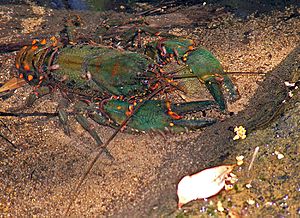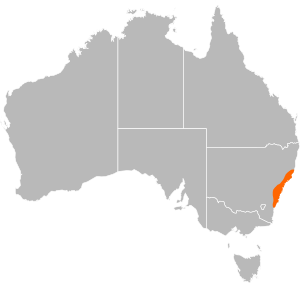Euastacus spinifer facts for kids
Quick facts for kids Euastacus spinifer |
|
|---|---|
 |
|
| Conservation status | |
| Scientific classification | |
| Kingdom: | |
| Phylum: | |
| Subphylum: | |
| Class: | |
| Order: | |
| Family: |
Parastacidae
|
| Genus: | |
| Species: |
E. spinifer
|
| Binomial name | |
| Euastacus spinifer (Heller, 1865)
|
|
 |
|
| Range of Euastacus spinifer (orange) in Australia | |
The Euastacus spinifer is a type of freshwater crayfish that lives only in Australia. It belongs to a family of crayfish called Parastacidae. These cool creatures are sometimes called spiny crayfish because of their bright spines!
Contents
Appearance of the Spiny Crayfish
Euastacus spinifer crayfish can look a bit different depending on which river system they come from. They are usually green with reddish-brown parts where their body segments join. Their most noticeable feature is their bright, colorful spines!
What Euastacus spinifer Eats
These crayfish mostly eat detritus, which is like tiny bits of dead plants and animals that have fallen to the bottom of the water. They are also known to eat small bugs and even tadpoles. Sometimes, they might even eat other smaller crayfish! They are considered "opportunistic omnivores," meaning they'll eat many different things they find.
Life Cycle of the Spiny Crayfish
Euastacus spinifer crayfish usually mate in winter when the water gets colder, around 15 degrees Celsius (59 degrees Fahrenheit). The female crayfish lays her eggs in early July. She carries these eggs on her swimmerets (small leg-like parts under her tail) for about 110 to 140 days.
Once the eggs hatch, the baby crayfish stay with their parents until early summer. Males usually become adults when they are 5 to 6 years old and about 11 centimeters (4.3 inches) long. Females take a bit longer, about 8 years, and grow to more than 14 centimeters (5.5 inches). There are also some smaller males that become adults when they are only about 4 centimeters (1.6 inches) long! The exact timing of their life cycle can vary slightly between different river systems.
How Big Do They Get?
Euastacus spinifer crayfish can grow quite large! They can reach up to 24 centimeters (9.4 inches) in length. The heaviest one ever recorded weighed about 1.8 kilograms (4 pounds). That's a big crayfish!
Where Euastacus spinifer Lives
These crayfish are found only in Australia. They can live in many different places, from areas near the sea all the way up to mountains as high as 1,200 meters (about 3,900 feet). They are spread out over a large area of about 55,000 square kilometers (21,235 square miles).
Spiny Crayfish Habitat
You can usually find Euastacus spinifer in creeks and estuaries. Estuaries are places where rivers meet the sea. Their homes are often shaded by lots of plants and trees, which helps keep the water cool and safe for them.
Moulting Process
Like many other crustaceans, Euastacus spinifer crayfish have to moult (shed their old shell) as they grow. Smaller crayfish moult more often, sometimes up to six times a year. Larger crayfish moult less, usually only once a year. The water temperature is thought to be a big reason why they moult at different times.


